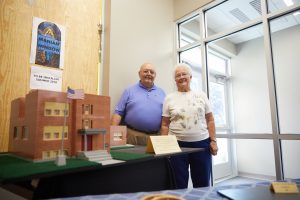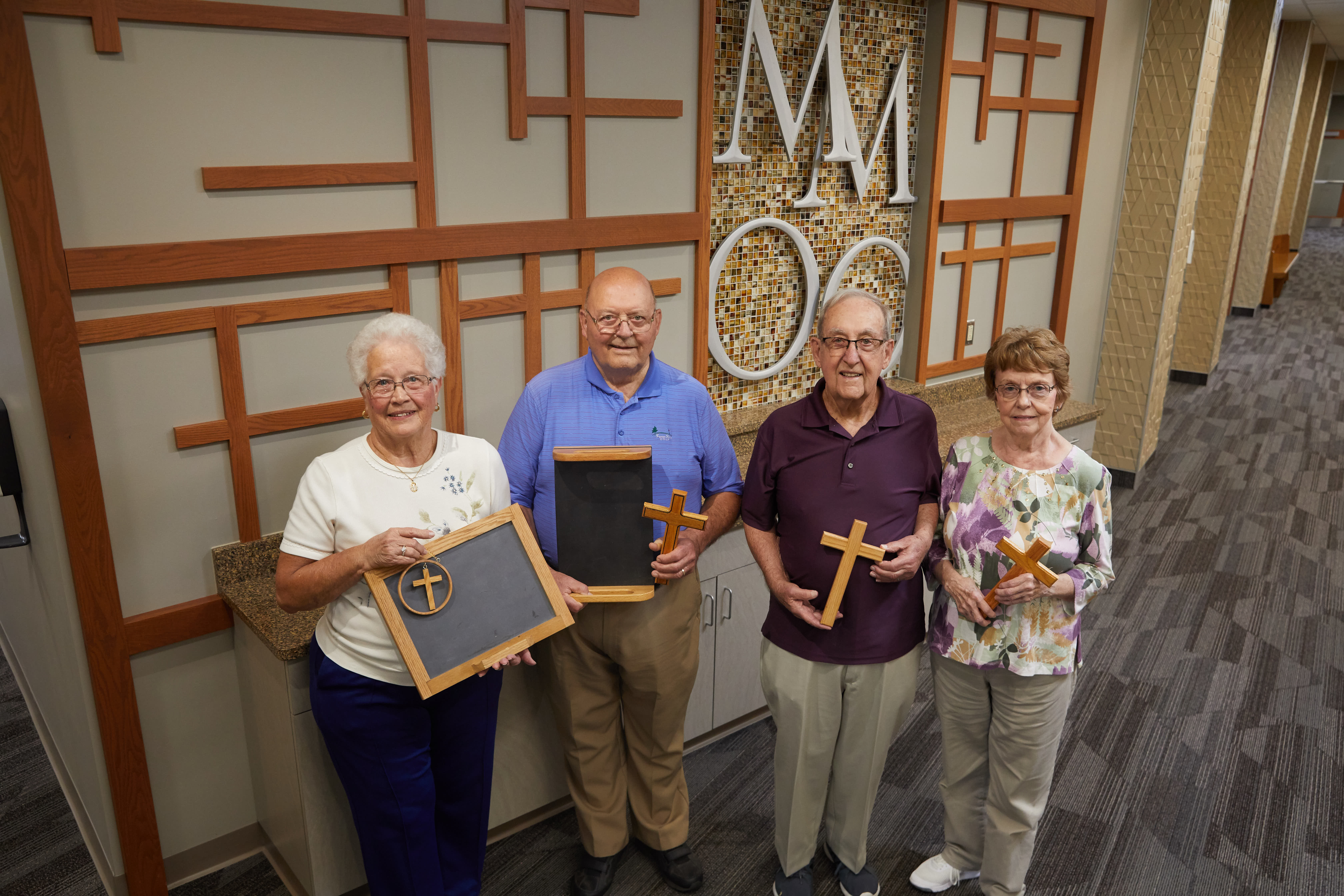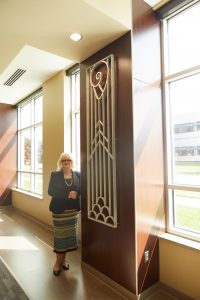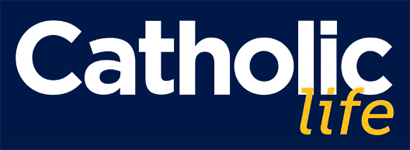Mary, Mother of the Church blends past and present with plans for the future
For those who wonder how two separate parishes can come together and successfully spread the good news, Mary, Mother of the Church Parish in La Crosse has navigated both separation and reconciliation with the grace of Christ. Today, the parishioners and the pastor, Father Brian Konopa, keep the best of Mary, Mother of the Church’s past as they plan for a strong future.

Standing in front of the newly constructed parish center, (left to right), Andy Foley, Director of Buildings and Grounds for Mary, Mother of the Church Parish. “This project and our collaboration with the best of the best in Fowler & Hammer and top notch sub-contractors has reinvigorated my faith and inspired me to work harder for our parish.” Sam Jaekel, Site Superintendent for Fowler & Hammer, “This is the best project I’ve ever been a part of.” Chris Huston, Vice President of Fowler & Hammer, “When projects turn out like this one, we build more than buildings.” Bob Flottmeyer, President & CEO of Chaseburg Manufacturing Inc. “It was great to be a part of this project, involved with the whole parish and the other sub-contractors. I’ve been with this parish my whole life since birth; it’s about time I gave something back.”
The south side of La Crosse saw St. Thomas More Parish open in 1946, with the school built first. Within 10 years, the baby boom sweeping post-World War II America meant an expansion was necessary for the school.
Just as St. Thomas More Parish was about to move forward with a church in 1960, Bishop John Patrick Treacy announced the creation of St. Pius X Parish to the south. Many members had to leave for the newly created parish.
“These two parishes struggled with debt most of their existence,” Father Konopa says.
In the 1990s, with parish attendance waning and fewer available priests, Bishop Raymond Burke united the parishes of St. Thomas More and St. Pius X in 2000 at the campus of St. Thomas More. Blending the distinctive congregations was a challenge, but everyone worked together to create a new parish family that numbers 1,000 households today.
In 2012, structural issues closed the school building, which was also used as their parish hall, moving Aquinas Catholic Schools’ early childhood to another building, religious education classes to Holy Trinity Parish and a majority of fundraisers and funeral dinners to the local Moose Lodge.
“We are very grateful to Holy Trinity for allowing us to use their classrooms,” says Father Konopa. “For six years, they didn’t charge us a penny.”
Father Konopa arrived as pastor in 2014, which was also the year the parish became debt-free. At the same time, parishioners had to decide how to move forward.
“There was no question we needed a parish hall, but there was a question of whether we should strengthen the school building or build a new building,” Father Konopa says. “In 2015, we began by asking for a wish list. If money were not a question, what would we want?”
Ideally, parishioners wanted a hall connected with the church, and it was also important to leave parish debt in the past.

Wally and Betty Stoll stand next to a replica of St. Thomas More School.
“We would only build what we could afford,” says Father Konopa. “It became obvious the best decision would be to build new.”
Deacon Richard Sage helped connect his fellow parishioners from St. Pius X during the merger and had a career working in finance for the diocese and as director of Catholic Charities. “I asked him if he would chair our building commission,” Father Konopa says. “We have been blessed with great people onthe parish staff; we couldn’t have done it without them.”
A building campaign, “Building Our Future Together,” had a goal to raise between $3.5 million and $4 million for the first major project for the unified parish. In addition to personal financial pledges from parishioners, fundraising efforts included sales of handcrafted items from wood and slate blackboards salvaged from the school building and the famous chicken-que dinners.
“We raised more than $4 million and built a beautiful parish hall,” Father Konopa says. “It generated a wonderful spirit in the parish. More than 80 percent of the parish responded. Some were only able to pledge prayers; others gave financial gifts as well. We had mentioned that we can’t all give the same amount, but we can all give a similar sacrifice to make this happen.”
Jesus Christ has been leading us through all this at a pace none of us could have foreseen.”

Therese and Joseph Van Oss, left, and Marita and George Smith sit by the Legacy Wall featuring the 1947 cornerstone of St. Thomas More School. It also includes the 1956 cornerstone from the addition built onto St. Thomas More School and the 1960 cornerstone of St. Thomas More Church. In the center is a statue of St. Pius X courtesy of Brother Michael Mandernach, the last of the Brothers of Pius X, and a statue of St. Thomas More that is a replica of the relief on the exterior of the church.
The demolition of the school provided a wealth of salvaged materials to incorporate into the new parish hall, bringing the parish’s past into the present. The letters MMOC on the inside of the parish hall entrance came from the original school sign ST. THOMAS MORE, with one letter O converted to the letter C.
The metal work from the front windows were transformed into artwork mounted on the wall of the dining hall. A legacy wall features the cornerstones of the schools, as well as statues of St. Pius X and St. Thomas More.
A diocesan treasure of a stained-glass window from the very first parish in the city, St. Mary’s, will be installed in the hall thanks to a $30,000 gift from non-parishioners. Aware that it was moving to the newest parish in the city named after Mary, the stained-glass company VanDerHoff Studios offered a discounted price for all the diocesan business over the years.
“We were trying to honor the past and not just push forward,” says Father Konopa of the loving incorporation of items to honor both St. Thomas More and St. Pius X Parishes, we also had the theme ‘Building Upon Our Legacy.’”
In 2017, the sad loss of parishioner Patricia McCabe provided an unexpected benefit for the parish in a gift of more than $300,000 from her estate. Suddenly, the future plan for a finished lower level to provide religious education classrooms and a music room became a present possibility.
The parish needed pledges or payments to reach $1 million by Jan. 31, 2018, for construction to continue. Without hesitation, the parishioners responded, and the Religious Education Center opened in September 2018, one or two years ahead of schedule.
“When I first arrived, I reminded them — and myself — that Jesus Christ is the pastor of this parish and I am His assistant,” Father Konopa says. “Jesus Christ has been leading us through all this at a pace none of us could have foreseen.”

Head woodworker, Wally Stoll and his wife Betty (left), and Jack and Pat Darling hold crosses and small blackboards made from wood and blackboards salvaged from the St. Thomas More School building.
Jack and Pat Darling
We joined the parish of St. Thomas More in 1959, when the church was under construction. The gymnasium of the school served as the parish church. All services were held there, including baptisms, funerals and weddings. The church was completed and dedicated in 1961.
When our daughters were in elementary school at St. Thomas More, we became involved with school activities. Many years later, when we retired, we wanted to focus our support on events of the parish.
We worked at the chicken-que, which at that time consisted of 800 dinners prepared by a caterer. After much discussion, we began to entertain the idea we could do this ourselves.
We volunteered to be the chairpersons for the event. We found a ministry we could do together.
When the two parishes merged, we were delighted. Suddenly, we had twice as many volunteers, and again the number of dinners increased.
In 2012, we were informed that the school would be closing. We were devastated. We had events planned and no parish facility.
After the closure, we looked for ways to continue the “now famous” chicken-que. We rented space at other locations and then decided to set up a tent and prepare the dinners on-site.
As we struggled to keep things going, plans for a new parish hall were being considered. Under the leadership of Father Konopa and Deacon Sage, our dream became a reality.
In the spring of 2018, our first chicken-que was held in the beautiful parish hall, where we served 1,800 dinners, 1,000 more than in our humble beginnings. The parish elected to redirect the more than $10,000 profit for local flood relief.
We retired from the chairmanship after 40 events and are grateful to have had the opportunity to work with the people of this wonderful parish.
Therese van Oss, director of religious education

Gloria Royer stands next to a metalwork motif from the St. Thomas More School building.
What excites me about being part of the dynamic parish of Mary, Mother of the Church is the deep love for the Holy Eucharist, which from the beginning of our reunification process in 2000 continues to be our source of grace and nourishment.
Through our relationship with Jesus Christ in the Holy Eucharist, our faith continues to grow in prayer and song, love and compassion and service to one another. As we celebrate our new parish hall and Religious Education Center, we are excited to have a place to gather to serve one another within our parish, our diocese and our community.
Finally, as we pray the Rosary before each weekday Mass, we recognize with deep gratitude that we are wrapped in the loving arms of Mary, Mother of the Church as we daily strive to follow her Son Jesus Christ. We recognize that all that has been accomplished in our parish is the work of the Holy Spirit, a pure gift of grace working within the hearts and souls of each of our parish members. We express our gratitude daily by striving to love and to serve God’s people in the building of the kingdom.
Joseph van Oss, MMOC webmaster
What excites me about MMOC are two words: parish family. My sisters and brothers in Christ, so warm, loving, generous, kind, and active, truly seem like family to me. They are a warm blanket of love that wraps around us, hugs us, through all things. And I love them right back. I know that if anything befell our family, my parish family would be there for us.
I know that the vibrant spirit of this parish is the Holy Spirit. And we are seeing an influx of young families, responding to that Spirit. That’s vitality.
And it is a dynamic parish! With God’s grace, this parish family accomplishes amazing things: a complete parish hall, kitchen and school in one year. Legendary chicken-ques that grow in numbers and reputation but never can seem to keep up with demand. Liturgy and music so beautiful that they replay in my mind all week long. And if worship is the heart of this parish family, then the PCCW and Men’s Club are its lungs.
I love that my parish family’s loving service goes out into our community like a wave. For example, when a tornado swept through La Crosse, MMOC was HQ for Catholic Charities’ relief efforts, and our people showed up in work gloves with chainsaws. When we learned that our recent efforts would go to our neighbors via Catholic Charities’ flood relief, our people seemed more fired up than ever.
When our member Mike Pederson died, we celebrated his funeral Mass on Super Bowl Sunday, 90 minutes before kickoff, and there wasn’t an empty seat in the church. That’s the Spirit of this parish — we are here for each other. I love my parish family, and, for me, their love is the best part of being Catholic.
By Mary Kay McPartlin
Photography by Michael Lieurance

